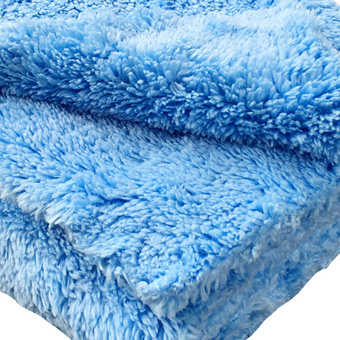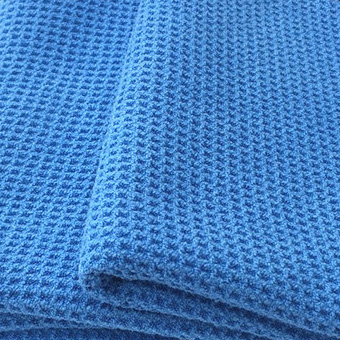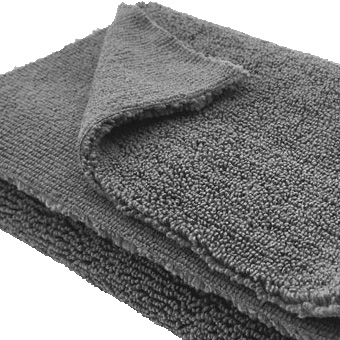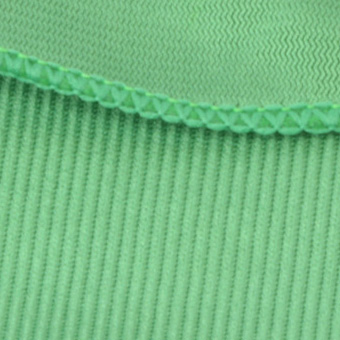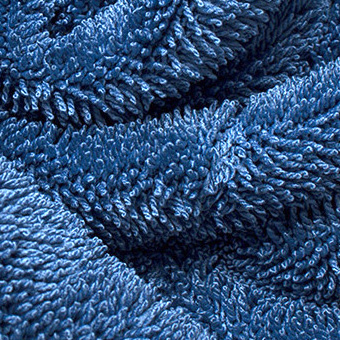Knowledge Base
Microfiber is an ultra fine synthetic fiber that has a strand weight of less than a singular denier. A denier is the number of grams 9,000 meters of a single strand of material weighs. This is smaller than the diameter of a strand of silk (approximately one denier), which is itself about 1/5 the diameter of a human hair. The smaller the denier measurement, the finer and more effective the microfiber.
The most common types of microfibers are made from polyesters, polyamides, or a conjugation of polyester, polyamide, and polypropylene. There are basically two types of microfiber: one is for cleaning products such as cleaning towels/mops and the other for clothing and furniture. The microfiber for cleaning is chemically split which adds considerable surface area to the fiber, and gives it a magnetic attraction to dust, dirt, and grime, while the microfiber made for furniture and clothing is non split, and repels dirt and liquids.
Microfiber vs. Cotton
Microfiber picks up and holds onto dirt, dust, and liquids while Cotton pushes it around.
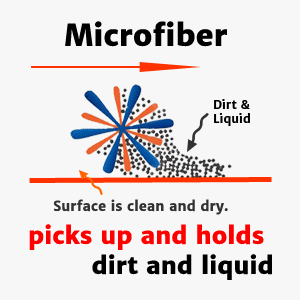
- Microfiber: The wedge-shaped microfibers grab the particles of dirt and pull the dirt into its dense internal structure where they remain until washed away with mild soap or detergent. Results are clean, streak free surfaces. The spaces between fibers allow large amounts of moisture to be collected into the microfiber cloths and make them very absorbent. These same spaces allow for quicker drying time eliminating much of the bacterial growth found in cotton cloths.
- Cotton:The rounded fibers on ordinary cotton cloths only push the dirt around and residue is left behind on the surface area you're cleaning. The structure of ordinary fiber cloth allows it to hold very little dirt.
Most microfiber used for commercial cleaning products are an 80/20 mix (80% polyester/20% polyamide) enabling them to absorb 6 to 8 times their weight in liquid. Since split microfibers are very fine — as much as 1/100th the diameter of a human hair, they are extremely soft and safe to use on delicate surfaces. Microfiber cleans without streaking, smearing, scratching or leaving lint.
As a professional manufacturer, we can make variety of microfiber cleaning products with different weaves and weave densities for specific types of tasks. We can produce a full line of microfiber cleaning products with different quality grades from economy to premium. Contact us for the right grade that works best for your specific cleaning tasks.
A super absorbent microfiber towel can hold up to six to eight times its weight in liquid . The amount of water that a towel can absorb is determined by the weight of the towel. Therefore, weight is one of the most important factors when it comes to choosing a microfiber towel.
Grammage can be figured as the grams per square meter (g/m2, GSM) of an object. Generally used for figuring paper density, it's equally useful when it comes to microfiber towels. Microfiber towels come in all sorts of different sizes and weights. A microfiber towel with a higher GSM weighs more than a towel with a lower GSM. The towel with higher GSM is typically thicker, and if there is a pile, it is plusher. Heavier towels will absorb more liquid than lighter towels.
Since thicker and heavier towels have more depth, they're good not only for heavy cleaning, but also for lighter jobs such as dry dusting; the deeper strands will capture and hold more dust. But thicker isn't necessarily better for all cleaning tasks. Workers who clean glass or polish a surface will want to use a tightly woven, but thinner microfiber towel. The better(more expensive) microfiber towels are actually tighter and more tightly woven.
Here are the most common GSMs of the microfiber towels being sold in the market.
- Terry Cloth: 200-400GSM
- Waffle Cloth: 300-500GSM
- Seude Cloth: 150-250GSM
- Glass Cloth: 200-300GSM
- Fluffy Cloth: 250-1200GSM
Microfiber towels are typically a blend of polyester and polyamide. The polyamide plays a critical role in splitting the fibers into ultra fine filaments. It is the spaces between split filaments or the wedge-shaped structure of microfibers that grab the particles of dirt and allow large amounts of moisture to be collected. Therefore, the finer the split filaments are, the more spaces a microfiber towel has for grabbing dirt and absorbing liquids.
There are currently five common blends of microfibers available in the industry:
- 70% Polyester and 30% Polyamide
- 75% Polyester and 25% Polyamide
- 80% Polyester and 20% Polyamide
- 85% Polyester and 15% Polyamide
- 90% Polyester and 10% Polyamide
Price competitions of microfiber cleaning products have become fierce, particularly for the general purpose microfiber cleaning cloths being sold by some discount stores. Most of the microfiber cleaning products in the market have been made in China. During the past years, the costs of materials and labors in China have increased considerably, while the market prices of microfiber cleaning products have kept unchanged or even reduced, due to price competitions. In order to continuously fulfill the huge orders for discount stores, manufacturers would have to cut material cost to break even or make profits. As a result, the quality of microfiber cleaning products from discount stores has been compromised. It is not difficult to find microfiber cloths with blends of 85% polyester and 15% polyamide, or 90% polyester and 10% polyamide.
Both the softness and absorbency of microfiber cloths depends how fine the split filaments of microfiber are. The polyamide component in microfiber plays a critical role in splitting the fibers into ultra fine filaments. The higher the percentage of polyamide, the more effective the splitting of microfiber. In order to obtain a better cleaning performance, look for the higher percentage of polyamide which indicates higher quality.
Customer satisfaction is our highest priority. Every microfiber cloth/towel we sell is made from microfiber of 80%/20% blend or 70%/30%. We we have full knowledge and confidence on each of the products we make and sell. We offer free samples with no shipping charges for business buyers. If you are not sure what microfiber cloths work best for your specific cleaning tasks, order our free samples before buy.
Microfiber Terry Towel
Microfiber terry towels are the most commonly sold microfiber towels. They are knitted from microfiber yarns with "terry loops" on both sides. Most of the microfiber towels sold at discount stores are of this style. Microfiber terry towels are soft and absorbent. They are great for all purpose cleaning, drying, polishing, dusting etc. Listed below are the quality grades of microfiber terry towels by GSM:
| 200GSM - Lightweight | Utility towels, disposable towels and industrial uses. |
|---|---|
| 250GSM - Economy | Household cleaning, shop towels, beach towels, hospital uses. |
| 300GSM - Commercial | Commercial cleaning, dairy towels, cafe & restaurant uses. |
| 350GSM - Professional | Prefesional drying towels for car wash, hair salon, pet bath. |
| 400GSM - Heavyweight | Premium quality for better absorbency and heavy-duty cleaning. |
Microfiber Coral Fleece Towel
Coral fleece is a fuzzy texture with dense weave and high piles of cut fibers. Microfiber coral fleece towels (or fluffy towels) feature long, soft and plush fibers on both sides that can easily pull particles away from the surfaces being wiped. They have become more and more popular in auto detailing industry, great for wax and polish residue removal, quick detail sprays, and delicate finish work.
The weights of microfiber coral fleece towels with single layers range from 200GSM up to 600GSM. Super thick microfiber fluffy towels with double layers can be made for super absorbency, with weights up to 1,200GSM. Weights of 400GSM through 600GSM are common choices for detailing towels, although towels of 800GSM through 1,200GSM are loved by many detailing professionals.
The softness of this fluffy towels can be further enhanced by using ultra fine 70/30 blend microfiber yarns. 70/30 500GSM 16"x16" edgeless fluffy towels are one of the best buffing/polishing towels for professional detailers, with a perfect combination of quality (plushness, softness and performance), price and size.
The fluffy microfiber coral fleece fabrics are also used to make bath towels, bathrobes, makeup removals, dusting towels and dust mops.
Microfiber Waffle Weave Towel
Super Absorbency: Waffle weave towels made from Pique fabric mimicking a waffle pattern that works like little cups for holding water and moisture. Unlike thick towels with a plush nap, waffle towels come with tighter weave that makes the towels thin and easy to wring water out of the towels. The special weave structure makes waffle weave towels be one of the best drying towels for car wash, hair drying, bath, and pet care.
Scouring Power: The ridges in the waffle weave act like little squeegees. These squeegees push the water and dust into the cupped portions of the fabric and give the fabric great scouring power for heavy-duty cleaning tasks.
Soft & Lint-Free: When waffle weave towels are made from ultra fine microfiber, they are soft, non-abrasive, and lint-free. Therefore, waffle weave microfiber towels are excellent choices for wiping glass, mirrors, windows.
The weights of waffle weave microfiber towels range from 200GSM up to 500GSM. When used as drying towels, the thicker and larger, the more absorbent. The most popular waffle weave microfiber drying towels are in sizes of 16"x24", 24"x24" and 24"x36" with density being around 400GSM. When used as cleaning towels for wiping glass, mirrors and windows, waffle weave microfiber towels with densities from 250GSM through 350gsm would do great jobs.
Microfiber Suede Towel
The suede texture microfiber is flat and dense fabric with no pile height. It is so named because of its appearance and feel similar to suede leather. Microfiber suede towels are extremely durable and nearly impossible to tear, and ideal for polishing metal surfaces. They leave a perfectly smooth, streak-free, flawless finish to aluminum, stainless or any other type of metal.
Suede microfiber towels are also soft and non-abrasive. They are commonly used for delicate surfaces you don't want to scratch: screens of electronics devices , eyeglasses, sunglasses and camera lenses.
Suede microfiber towels have become more and more popular as beach towels and sports & travel towels. Made of fine quality suede microfiber, microfiber suede towels are compact, absorbent and fast drying. They are lightweight and easy to roll and pack regardless of what you use them for. When used as drying towels after a swim or bath at gym, they absorb water on bodies effectively. Plus, they dry off quite easily and quickly.
The weight of microfiber suede varies narrowly from 180GSM up to 250GSM. The most common weights of suede texture microfiber cloths/towels are around 200GSM. Because of flatness and lightweight, suede microfiber towels are one of best choices for promotional items with imprinting artwork.
Dual Pile Microfiber Towel
Dual Pile Microfiber Towels are a variation of general purpose microfiber terry towels. They have one side of standard length of terry loops and other side with extra length of terry loops. The longer terry loops create high piles that make the towels more absorbent, softer, and plusher. These thick and plush towels are versatile towels most commonly used as drying towels in car wash, buffing/polishing towels in auto detailing, and cleaning/dusting towels in janitorial cleaning.
Dual pile microfiber towels are commonly made as ultra plush and premium quality towels with high weights ranging from 350GSM and 400GSM.
For those of you who are looking for versatile microfiber towels for auto detailing, this dual pile microfiber towels would be one of your best choices:
- Wax Removal: Use plush side for removing wax residuals and short nap side for polishing the surfaces;
- Drying Towel: Soft and thirsty, a very good alternative of waffle drying towels at lower cost;
- Interior Cleaning: This thick and plush towel can be very effective in interior cleaning and dusting;
Microfiber Pearl Towel
Microfiber pearl towel features tighter weaves and shorter naps than general purpose microfiber terry towels, with excellent scrubbing action. For those of you who are looking for premium quality all purpose microfiber towels with super absorbency and effective cleaning power, microfiber pearl towels are your choice.
Microfiber pearl towels are made to be versatile detailing towels for tough and dirty jobs.
- Polishing Towel: The tight and short naps make pearl towels be very effective for the removal of ceramic coatings, compounds, spray detailers, polish, wax, and more;
- Glass Cleaning: The tight weaves make a pearl towel be an efficient lint-free glass cleaning towel that leaves as little water or glass cleaner as possible so the light droplets will evaporate quickly without leaving spots.
- Heavy Duty Cleaning: The gripping power of the short naps help a pearl towel remove quickly & easily dust and debris in door jambs, dirty seats, or seat rails of cars.
Microfiber pearl towels can be made with weights from 250GSM up to 400GSM. The standard weight for commercial quality microfiber pearl towels is 300GSM.
Microfiber Glass Towel
Microfiber glass & window towels are made from tight weave microfiber fabrics with unique dual-texture design that has a dirt and grime-gripping ribbed surface on one side and a silky smooth finish to wipe away any streaks on the other side. They are very durable and perform extremely well on glass and mirrors. The ribs act as thousands of tiny squeegees that remove the toughest residue from all glass surfaces.
Microfiber glass towels can be made with weights from 250GSM up to 350GSM. The standard weight for commercial quality microfiber pearl towels is 300GSM.
Microfiber glass & window towels can provide outstanding lint-free, streak-free results on glass surfaces and screens of eletronic devices. They are commonly used in household/commercial cleaning and auto detailing.
Microfiber Twisted Terry Towel
Microfiber twisted terry towels feature twisted terry loops that greatly increase the pile length and fiber surface contact for faster drying and higher absorbency.
For single layer microfiber twisted terry towels, long piles of twisted terry are knitted on the front side, with tight nubs on the back side. They have become a new generation of glass & window cleaning towels for car wash and auto detailing.
The weights of twisted terry towels with single layers range from 300GSM up to 600GSM. Therefore, the weights of double layer microfiber twisted terry towels can range from 600GSM through 1,200GSM. What makes microfiber twisted towels be the best drying towels are the features below:
- Super Absorbency: The weights of the new twisted terry microfiber drying towels range from 800GSM to 1,200GSM, while the most popular waffle weave microfiber drying towels can have weights only up to 500GSM;
- High Performance: Although thick with long piles, microfiber twisted terry towels do not produce the surface tension and drag that other ultra thick and plush towels do;
- Easy to Wring: Since microfiber twisted towels are tightly knitted, they are easy to be held and wrung.
General Purpose
The general purpose microfiber towels are made from the standard terry weave and a blend of polyester/polyamide. They have medium thickness naps are usually thicker than a microfiber polishing towel but not as plush as a microfiber buffing towel.
This type of microfiber towels have no specific purposes and can be equally adept for most of the cleaning tasks. In auto detailing, they are an excellent choice for interior cleaning as well as some of the dirtier jobs that you wouldn't want to use your good microfiber polishing or buffing towel on the exterior.
The densities of microfiber terry towels range between 200GSM and 400GSM.
Glass & Polishing
Microfiber towels that work well for polishing and glass cleaning seem to have the same basic characteristics. First, the towel should be 100% lint free. To achieve this, the towels have tighter weaves and shorter naps than general purpose towels.
For wax and polish residue removal it is important that the nap is short so that the microfiber loops can grip the product residue with little effort. This also makes the microfiber polishing towel an efficient glass cleaning towel that leaves as little water or glass cleaner as possible so the light droplets will evaporate quickly without leaving spots. A good glass towel needs the gripping power of the short nap to successfully remove the residue that causes streaking.
Microfiber glass & polishing towels are generally medium / short nap towels which have a little more bite to remove dried polishes / waxes. They are made of thinner and more firmer material which provide that "bite", with densities being ranged between 220GSM and 300GSM.
Drying
There are two different microfiber weaves that make good drying towels: ultra plush terry and waffle weave.
An ultra plush terry towel is two sided, with a long pile on the front side and a short pile on the back side. It works well for drying.
The most popular drying towel material is the Pique fabric that mimics a waffle pattern. The waffle weave design allows the towel to be thinner as the waffle weave works like little cups that absorb the water. The waffle weave makes the towel a more efficient drying towel as it is absorbent, yet thin enough to wring out easily.
Pique fabric isn't more absorbent than terry but the ridges of act as hundreds of little squeegees which push the water up into the cups giving the fabric time to absorb. As with the terry material, it's best to find a fabric that's not too heavy, or you won't be able to wring it out when it gets saturated.
The densities of drying towels are usually 400 or up. The highest quality drying towels offer satin bound edging.
Cleaning
There are a few microfiber weaves that are marketed specifically as "cleaning towels". The nap is very tight and course, and the microfiber strands are not split. These towels have very little absorbency. The intended purpose of these towels is janitorial work, not car detailing.
Fallen in this category of microfiber cleaning towels are pearl weave towels and waffle weave towels.
Buffing
A microfiber buffing towel is designed for lighter jobs such as light wax residue removal and quick detailing. A quality microfiber buffing towel is a thick, fluffy microfiber that is super soft.
One of the most popular microfiber buffing towels is the ultra plush terry towels that offers a dual nap with a long plush nap on one side and a slightly shorter nap on the other side. Side one is a tight terry towel weave with exceptional waxing power. It excels at buffing off carnauba waxes and sealants. Side two is a deep, plush, terry pile that loves detailing sprays and will bring up the full luster of your paint. Microfiber Buffing Towel is two towels in one!
This fluffy microfiber buffing towel is gentle and works well for removing light wax residue with very little effort and is the perfect choice for quick detailing.
Final Buffing
A couple years ago microfiber "suede" fabrics hit the toweling market. These fabrics crossed over into the automobile detailing arena as final wipe towels and final buffing bonnets. I have not been overly impressed with the fabric for automotive use. It is soft, but it does not seem to perform any better on paint (for final buffing) than a general purpose towel.
The Buffing Towel has a nice bound and stitched border for scratchless use. The towel has a dual nap that also makes it an excellent choice for buffing off waxes and quick detailing.
Dusting
Microfiber cleaning towels make the chore of dusting quick and easy; the special fibers catch dust and dander and trap it more readily than most other methods, making long, quick dusting sweeps effective and efficient. Medium-grade microfiber towels are typically ideal for dusting, because they are less expensive than high-grade towels, but the tighter weave picks up more dust than lower grade cleaning towels.
The small weave of microfiber ensures better cleaning. Some types of microfiber toweles are charged with static electricity, helping to attract loose dust from any surface.
Mopping
With mopping, there are two categories for microfiber, wet and dry pads. Wet microfiber pads have a coarse texture, allowing for better scrubbing ability yet moves across the floor easily. Dry pads are used for dust mopping and have a softer texture.
Shining
Many households hold items or furniture that need to be buffed and shined regularly. For those who wish to avoid using harsh chemicals while still aiming for the best streak-free shine, there are special, small shining and buffing microfiber cleaning towels . These towels are often a finer variety of window-cleaning microfiber towels, with a super-tight weave and luxurious suede feel, and allow users to easily buff and shine precious pieces without the risk of damage from cleaning chemicals.
Hair Turban
No more 'balancing act' with a cotton bath towel wrapped around your head. Use a microfiber hair turban after washing or wetting your hair. With the incredible absorption capabilities of the microfiber material, microfiber hair turbans let your hair practically dry itself. This means less damage to your hair from the hair dryer. Also, you'll notice much less tangling since you don't have to rub your hair to dry it.
Sports & Travels
Traditional towels can be really annoying when it comes to packing and travelling. First of all they are bulky and require a lot of space. Secondly, you cannot just pack one towel. You have to pack two or three of those suckers and lastly, well, they are just a nuisance. But not anymore! You don't have to deal with those heavy traditional towels anymore. Instead just pack a couple of microfiber travel towel and you are good to go.
Specially designed travel towels provide an excellent alternative to traditional towels. The most popular travel towels are ones made of fine quality microfiber suede fabrics. This material is soft like velvet and smooth like a baby's skin. Microfiber travel towels are absorbent, fast drying, durable and versatile. They are lightweight and easy to roll and pack regardless of what you use them for. If you go for a swim and come out to dry, they absorb water faster. Plus, they dry off quite easily and quickly. For a large size travel towel, when folded, it becomes compact and you can store it anywhere easily. You can carry it around in your gym bag, your suitcase, a bag and even in a purse!
Pile is a term used to describe each visible strand of a microfiber towel. Each pile is constructed of thousands upon thousands of individual microfiber strands. There are 4 general pile types: ultra-low pile, low pile, medium pile and high pile. There are variations on these, however for clarity's sake these are the main types widely sold in the market. Generally, the longer the pile the softer the towel will feel. This is not always the case, but it is partial truth because the more piles that come in contact with and conform to your hand (or any surface), the softer the towel will feel. Below are the four general pile types and their characteristics:
Ultra Low Pile
Ultra low [no pile] are the towels you receive when you buy new glasses or sunglasses. They are suited for trapping and removing human oils and tiny particles without smearing. These are almost utterly useless for any other sorts of tasks. It is most likely that ultra low microfiber towels are made of microfiber suede fabrics with either smooth surfaces or brushed surfaces.
Recommended uses: Glass cleaning, navigation / electronics console cleaning.
Low Pile
Low pile is best suited for the removal of compounds, polishes, and waxes. Since the pile is short is has no give (movement away from) in regards to the surface it's in contact with, it cannot shift and is forced into action, trapping up whatever is on top of the contacted surface. That is why it is considered 'grabby' and is the best sort of 'scrubbing' microfiber pile.
The pear weave towels, waffle weave towels, and other types for polishing towels fall in this category of low pile towels. The single sided general purpose microfiber terry towels with short naps also belong to this category.
Recommended uses: Removal of compounds, polishes, waxes. Stubborn spot removal on hard surfaces
Medium Pile
Medium pile microfiber towels are great for general cleaning and can be considered the base level of absorbency, when used for drying purposes.
Often medium piles come with the ultra plush microfiber towels that are manufactured with a low pile side and a medium pile side, allowing for versatility of usage. It should be noted that these are especially versatile for interior cleaning with the two different pile types they can tackle most any task inside a vehicle.
Recommended uses: general cleaning, interior cleaning, light drying.
High Pile
High pile is best for ultra-absorbency and trapping of the most debris. Both of these are due to the fact that a longer pile allows for more surface area of the towel.
Recommended uses: drying, waterless washing, quick detailer.
When determining what grade or type of microfiber towel to buy, the best thing to do is examine the intended use of the towel. In many cases, manufacturers and industries have zeroed in on the perfect applications for each grade range of microfiber towels. In most cases,
- the tighter the weave, softer the feel, and
- the thinner the towel, the higher grade the microfiber is.
Industrial Use
Several industries use microfiber cleaning towels as a standard cleaning or care products. In most cases, microfiber cleaning towel manufacturers produce and market specific types of towels for those intended applications.
- Industrial Cleaning: Industrial cleaning companies use microfiber cleaning towels for dozens of applications because of their superior performance compared to standard fabric rags or paper products. In most cases, microfiber cleaning towel manufacturers provide these companies with microfiber cleaning towels of different grades that are color-coded to the tasks the towels are intended to perform. The higher grades of these towels are manufactured to be able to clean and shine objects without the use of chemicals.
- Automotive Repair: Working in the automotive industry means dealing with a wide assortment of chemicals, oils, and greases. Special microfiber cleaning towels are manufactured and marketed for the express purpose of use in the automotive industry, and generally come in the form of disposable, small wipes with a loose weave, which makes them tough on grease and oils.
Medical Use
Many hospitals and patient-care facilities use microfiber cleaning towels in their cleaning procedures because the tight weave and small fibers allows the towels to clean more deeply and easily than other products and without the use of harsh astringents. This makes them ideal for use in patient contact areas, ensuring a reduced rate of pathogenesis between patients and a reduced risk for infection or environmentally-related complications.
Outdoor Use
Generally, a microfiber cleaning towel intended for outdoor use should be of a lower grade than one intended for indoor applications. A lower grade with looser weave will allow the towel to more easily handle powerful stains, messes, and dirt.
- Auto Detailing: For those car owners who like to give their vehicle the best of care after washing, there are always auto detailing microfiber cleaning towels . These towels, like some other varieties, are high-grade with a special tight weave. To make the job easier, some manufacturers even provide car detailing microfiber mitts alongside towel and towel products.
- Window Washing: The use of paper towels and woven rags to clean windows can leave streaks, paper fiber, or string behind on the glass. To prevent this, many use specialized microfiber towels to clean and dry their windows. Window washing microfiber towels tend to feature a tighter weave than many other varieties of microfiber towels, making them high-grade. They are typically much thinner than other varieties, with a suede-like texture.
- Sports & Travel: Specially designed travel towel provide an excellent alternative to traditional towels. Travel towel are durable and versatile, they are light and easy to roll and pack regardless of what you use them for. If you go for a swim and come out to dry, they absorb water faster. Plus, they dry off quite easily and quickly. The most popular travel towel are ones made of microfiber material. This material is smooth and soft as compared to chamois leather. There are a variety of travel towels you can choose from and here are some:
Indoor Use
Microfiber cleaning towels are most commonly used for indoor applications and general indoor cleaning. They are made of thinner materials and fabrics than both outdoor and industrial varieties, and for that reason, are unsuited to heavy use.
- Hair Drying: Low-grade, loose weave microfiber cleaning towels can also be used to help dry hair after showers. For those with hair easily broken or damaged by blow-drying, these towels are super absorbent but also soft and gentle, resulting in less breakages and reduced roughened and split ends. Because of the special types of fibers used, they are also incredibly absorbent, making hair-drying a breeze compared to using traditional cotton towels.
- Kitchen: Kitchen microfiber cleaning towels are usually either low or medium grade microfiber. Smaller surface areas with more polished surfaces will typically require medium grade microfibers for optimum maintenance, while less-polished kitchens with tougher stains, oils, and grease to clean would likely benefit more from low grade microfiber towels. Some manufacturers make specially-designed rolls or boxes of microfiber cleaning towel sheets specifically for kitchen use, so soiled towels can be readily disposed of.
- Dusting: Microfiber cleaning towels make the chore of dusting quick and easy; the special fibers catch dust and dander and trap it more readily than most other methods, making long, quick dusting sweeps effective and efficient. Medium-grade microfiber towels are typically ideal for dusting, because they are less expensive than high-grade towels, but the tighter weave picks up more dust than lower grade cleaning towels.
- Shining: Many households hold items or furniture that need to be buffed and shined regularly. For those who wish to avoid using harsh chemicals while still aiming for the best streak-free shine, there are special, small shining and buffing microfiber cleaning towels . These towels are often a finer variety of window-cleaning microfiber towels, with a super-tight weave and luxurious suede feel, and allow users to easily buff and shine precious pieces without the risk of damage from cleaning chemicals.
- Flat Mop Pads: Low or mid-grade microfiber cleaning towels can be used as a replacement for both wet and dry Swiffer pads. This can be cost-effective for many families, as microfiber towels can be easily reused by simply running them through a wash cycle.
Microfiber towels are made up of tiny loops that naturally capture dust, lint, and miniscule bits of debris, and they do a fantastic job of cleaning and polishing everything from eyeglasses to fine wood finishes. They require special care to continue working to their fullest potential. Use the following easy steps to wash and care for microfiber cloths, and extend their life of uses.
- Wash Them Separately: To keep microfiber cloths in top condition, do not wash them with anything else. They can be washed with other microfiber cloths, but not with towels, other rags, or any other fabric. If the are washed with other items they will gather lint that will be transferred back onto surfaces being cleaned. Be sure to use the small wash load setting to save water, and use laundry soap sparingly.
- Do Not Use Bleach: Bleach will break down and erode the integrity of the split microfiber strands, your towels will lose their absorbency, and dust clinging ability, they will become rough and ineffective. If necessary, they can be soaked in very warm water and a small amount of the usual laundry detergent. Simply shake off each one before tossing into the wash, and add the proper amount of laundry detergent according to product label directions.
- Dry Them without Fabric Softener:Fabric softener can ruin the absorbency of microfiber cloths. Wash them as instructed above, and line dry them if possible. Otherwise, toss them into a dryer without fabric softener. They will be naturally soft and absorbent without softener that would ultimately ruin the fabric.
- Store Them Away from Ordinary Rags:Microfiber cloths stored with ordinary rags or towels can also pick up and hold unwanted lint. Wash and dry the cloths as indicated, and store them separately. This way everything they touch will remain lint-free, and they will work as well as they did when they were new.


